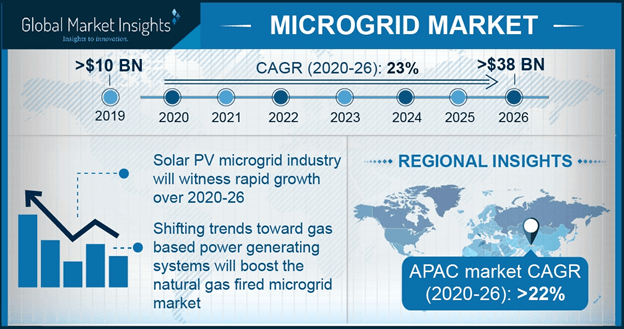Microgrid market to gain massive prominence over 2017-2024 driven by numerous government initiatives targeted toward grid establishments in inaccessible areas
Publisher : Fractovia | Published Date : 2017-12-13Request Sample
Powered by the quest to deliver uninterrupted electricity to remote locations across the globe, microgrid market players seem to be on an expedition to bring forth a range of highly advanced networks endowed with supreme connectivity and storage that would help electrify rural and outlandish areas. In an era thriving on the notion of circumventing the deployment of fossil-fuel resources and promoting sustainability by and large, microgrid industry outlook is likely to witness a transformation at the paramount stratum. The declaration has been amply and impeccably testified by the extensive launch of these grids across numerous regions where power supply is still a luxury. For instance, Robben Island, the World Heritage Site in Cape Town, has recently witnessed the launch of an R25-million solar energy, lithium-ion battery storage microgrid. The region had been dependent on diesel since long for power generation, however, now, with the launch of this microgrid, it is expected that Robben Island would prove to be a viable exemplar to stimulate microgrid market demand. The Li-Io battery storage microgrid installation has been forecast to reduce the usage of close to 600,000 liters of carbon-emitting fuel, underlining how effectively microgrids can be used for electricity generation in fuel-powered areas, thereby benefitting the overall microgrid market outlook.
Europe Microgrid Market Size, By Power Source, 2016 & 2024 (USD million)

The contribution of governmental bodies toward microgrid industry expansion
Regional governments and regulatory bodies have a rather influential role to play in the development of microgrid market. Given that the demand for electricity and the dire need for optimized power consumption are globally prevalent issues, the trends witnessed across this business vertical have a tremendous influence on the overall energy mix, which has spurred the interest of regional and international governmental bodies. In consequence, a series of highly profitable initiatives have been witnessed across microgrid market lately, a concise gist of which has been outlined below:
- Merely a week ago, the Massac.husetts Department of Public Utilities and The Boston City Council took a step forward toward contributing their bit toward microgrid market growth. The city council apparently, has approved the Docket 0340 – a proposal for the state legislature to pave the way for constructing a microgrid at the Raymond L. Flynn marine park. In the event that the state lawmakers give the green signal, this would be the first time an energy savings performance contract (ESPC) would be approved for a project excluding solely publicly-held buildings. Through a legal request, the ESPC would be signed with another reliable business partner to construct the microgrid at the 191-acre navy yard – a project that would have a commendable impact on the growth graph of the regional microgrid industry.
- In 2016, the MNRE (Ministry of New and Renewable Energy) apparently drafted a national policy for mini and microgrids, that chalked out a plan including 10,000 mini and microgrids with a generation capacity of 500 MW in the next five years. Despite the fact that the policy approval is still underway, and that certain nuances are yet to worked upon, the proposal still marks considerable significance in microgrid market, since it validates that governments are inherently conscious of the significance of grid installations to combat power supply across rural areas.
- The Secretary of the Philippine Department of Energy (DOE), Mr. Alfonso G. Cusi, has recently outlined the aim of the Filipino government to further stimulate the deployment of mini and microgrids in the country by tapping renewable energy. Through this long-standing goal, the Filipino government intends to achieve its vision of achieving total electrification by 2022. Philippines’s goal is likely to validate the extent of government intervention in microgrid market, which may substantially impel the revenue graph of this business vertical in the years ahead.
The buzzing trends of sustainability and reduced energy consumption have led to the mandatory implementation of power grids to ensure an unlimited supply of electricity. In the years to come, it has been forecast that the robust requirement for electricity will generate a substantially extensive demand for power grids to be installed at strategic locations and remotely inaccessible areas. In consequence, this would encourage microgrid market players to go the whole hog and come up with unique and reliable products that would be easy to install and operate. In fact, plans are already underway for massive grid installations - PanaHome, a unit of Panasonic, in tandem with the METI (Ministry of Economy, Trade and Industry), has revealed that the company has plans to connect 117 homes in the western part of Japan, to a solar-powered microgrid system. Panasonic’s venture proves that microgrid industry players are being influenced by the growing need to integrate renewables such as solar and wind energy in the national grid.
It is also prudent to mention that lately, microgrid market companies have been motivated to tap into areas prone to disasters - such as those that are prone to hurricanes, tornados, earthquakes, and the like, given how crucially pivotal microgrid installations have proven to be in these areas. Driven by the mammoth participation of regional governments and the presence of a stringent regulatory framework, microgrid market size is expected to cross USD 19 billion by 2024 – nearly five times the original valuation of this business space in 2016.